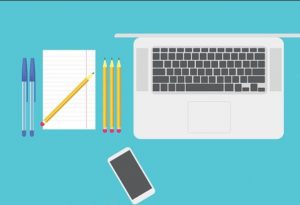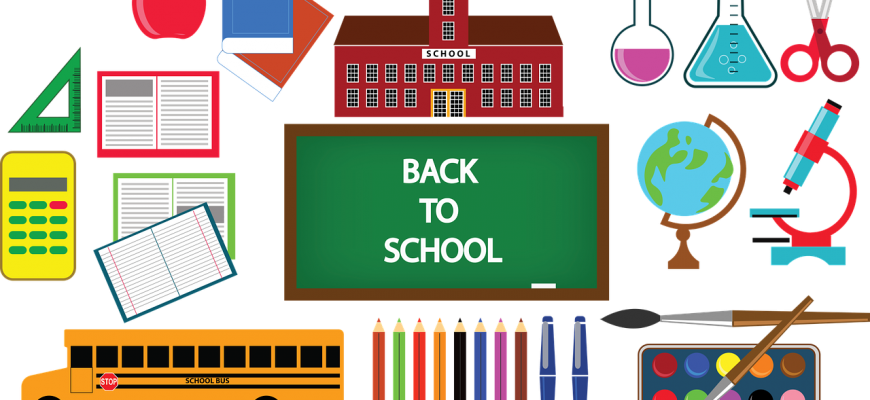Heading Back to School
Parents have very different concerns this year for getting their children ready for going back to school. Instruction varies from state to state, county to county, or district to district. Students may find themselves learning virtually, in-person, or a combination of the two. Regardless of how the instruction is delivered, students still need to study and complete homework at home, they still need school supplies, and they may benefit from finding various places to study to keep them engaged. Whatever method of instructional delivery your child receives, here are some tips and tricks to get your child ready for the new school year.
How to Study and Complete Homework at Home
Organization, a structured schedule, and a productive workspace are essential to the success in studying and completing homework. In schools, students have regular schedules that align with instruction and learning. They need the same consistency at home. Help your child create a consistent schedule at home if they have to go to school virtually, one they can post above their work areas (desk and chair with ample lighting). Make a grid with the days of the week and list the blocks of time to make it easy for your child to follow (if your child’s school or classroom has a specific schedule, then follow that schedule and add homework time to the end prior to dinner). Color code the schedule to help your child remember the blocks of time to complete each subject. 
Don’t Forget Breaks
Don’t forget that breaks are important. Children who attend middle school and high school have classes that are about 45-50 minutes long. Subjects are broken down even shorter for elementary aged students, so make sure that your child gets ample breaks each hour.
Homework Time
Complete homework right after school after a nutritional break. Also, make sure to add time for getting home and settling down. Homework times vary, typically growing based on the student’s grade level. A kindergarten student may finish homework in 10-20 minutes, whereas a high school senior in five Advanced Placement classes may need several hours.
Workplaces are Important
Regardless of the age, each student needs a structured workplace with clear expectations of when the work should be completed. Give children consistent structure and expectations right from the beginning. They will learn to continue with those study habits. Make sure the workplace is free of distractions. The materials need to be readily available. Young children work best in an open area with parent support, such as the kitchen table. As they grow older, then they may benefit from having their own desk and chair for the tablet or computer issued by the school and their school supplies in their desk drawers or a crate so they can easily store their textbooks, notebooks, and supplies. Let’s discuss how school supplies can help children in their studies.
The Best School Supplies
Whether your child is going back to school in the classroom or virtual environment, there are basic school supplies that children need to promote their success and organization. Depending upon their grade levels, different types of paper can help them practice and improve their writing. Younger children in grades PreK-grade 1 need lined paper to learn how to write.  Whereas older elementary school-aged children can use wide-ruled notebook paper and middle school or high school aged students typically prefer college-ruled notebook paper. Children in grades 2-high school benefit from using a binder with divider tabs (pockets are an option to help when hole-punchers are not readily available). Younger children tend to use smaller binders (1-1.5 inches) and as children age, then they need to get larger binders.
Whereas older elementary school-aged children can use wide-ruled notebook paper and middle school or high school aged students typically prefer college-ruled notebook paper. Children in grades 2-high school benefit from using a binder with divider tabs (pockets are an option to help when hole-punchers are not readily available). Younger children tend to use smaller binders (1-1.5 inches) and as children age, then they need to get larger binders.
Teachers/Schools Recommend Supplies
Teachers usually have specific classroom supply lists that they prefer their students to have from types of pencils and pens to types of organizational tools. Make sure to check with your children’s teachers prior to school starting to get their recommended supply lists.
 If your child is able to return to the classroom this fall, then other important supplies include a sturdy backpack, lunchbox, and pencil box/bag that can hold the pencils, crayons or colored pencils, markers, highlighters, and pens. Many schools provide a computer or tablet to each student or family, so make sure to review the instructional technology available for check-out with your child’s school especially with the need for virtual instruction or to complete their work at home during the health crisis. Educators work with families to help the students to be equipped for the new school year, When in doubt, check with your children’s teachers for the materials that would best work with their classes.
If your child is able to return to the classroom this fall, then other important supplies include a sturdy backpack, lunchbox, and pencil box/bag that can hold the pencils, crayons or colored pencils, markers, highlighters, and pens. Many schools provide a computer or tablet to each student or family, so make sure to review the instructional technology available for check-out with your child’s school especially with the need for virtual instruction or to complete their work at home during the health crisis. Educators work with families to help the students to be equipped for the new school year, When in doubt, check with your children’s teachers for the materials that would best work with their classes.
Places on Property to Study
Above all else, beware of distractions. It’s important to find a place to study that is free of distractions. Some experts will tell you that a dorm room is a terrible place to study, but a dorm room isn’t a bedroom. Bedrooms can have their pluses and minuses. If your child’s bedroom has a structured study area that is organized and free of distractions, then it can be a fine place to study.
Places to Study at Onyx
As children age, they tend to want to study elsewhere and middle school, high school, and college students may want to meet with their friends to study. The Onyx community offers many areas that students can study on their own or in small groups. The Active Club Lounge, Dipping Pool with Spa Cabanas and Lounge, Fresh Air Game Lounge, and Secluded Outdoor Lounge are places students can go to study alone or with friends.
Studying outdoors doesn’t mean just studying by the pool, and the sun and fresh air can help students stay alert and motivated. The Fresh Community Rooftop Garden and Expansive Courtyards are fun places to meet with friends to study or complete a project. The Modern Fitness Center may be a fun place to read as well plus reading when working out on the exercise bike or treadmill is a great way to stay fit for both the mind and body. Onyx has areas that are user friendly for study groups or studying outside the home.
Studying in the Community
In the community, parks, the local library, and even the local coffee shop are great places to study. Beware of distractions. Balancing the work and play helps to keep children interested and inspired.
The New Normal
Going back to school especially in a year with so many changes and unknowns can be stressful, but it doesn’t have to be difficult. The basics are the same, children still need school supplies, a structured schedule, and an organized place to study. Parents are their support, offering them the praise and help as situations arise. With the health crisis, parents may be their teachers. Normalize the situation and help them understand why in a positive way. Remember, you were their teachers for their first five years before they started school and even after. You keep them safe, keep them engaged, and keep them happy. This school year can be just as normal as any other if you help them through it.


